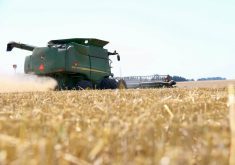Merck and Co. recruited Temple Grandin, an advocate for the humane treatment of livestock, to be on a board that will consult on the company’s Zilmax feed additive, which has been temporarily taken off the U.S. and Canadian markets following animal welfare concerns.
Grandin, who frequently works for the meat industry, said she agreed to serve on the panel. Merck declined to divulge the identities of group invitees before board membership was set.
Reuters has spoken to Grandin several times since Tyson Foods on Aug. 7 said it would stop accepting beef fed Zilmax beginning next month. Below is an edited transcript of Grandin’s answers to Reuters’ questions.
Read Also

U.S. livestock: Cattle make small gains, hogs fall
Chicago cattle futures made modest gains on Monday while hogs pulled back. Most-active February live cattle closed at 230.550 cents…
Zilmax and other beta-agonists, a class of non-hormone growth promotants, are fed to cattle to add weight and reduce fat content in the meat prior to slaughter.
Grandin has designed equipment widely used in slaughterhouses. McDonald’s, Cargill and Whole Foods are among her clients. She told Reuters she has observed a succession of behavioral problems with cattle fed beta-agonists such as Zilmax , sold in Canada by Intervet, and Optaflexx, marketed by Eli Lilly’s Elanco unit.
Merck told Reuters it believes Zilmax is safe and the company is not aware of problems beyond those observed during the U.S. Food and Drug Administration approval process. It has said it needs time to “audit” how Zilmax was being used.
Elanco said in a statement that its agricultural feed supplement has been safely given to tens of millions of cattle, and reports of animals displaying problems “related to Optaflexx are very rare, and have decreased over time.”
Q: Tyson said its decision to stop buying Zilmax-fed cattle was based on animal welfare concerns. Have you noticed any issues at the slaughterhouses where you have worked?
A: When beta-agonists first came on the market in the early 2000s I worked at packing plants all the time. I started seeing problems showing up at packing plants that I’ve never seen before: stiff, sore-footed lameness and a lot of heat stress symptoms, including in Brahman cattle who are usually heat resistant. I want to emphasize not every group of cattle fed beta-agonists have this problem. Some groups of cattle have the problem and some don’t. I call it the “odd unevenness.”
Q: Have these issues been constant across the years?
A: I have seen it at five different plants with six different groups of cattle around the country. I saw it when ractopamine (Optaflexx) came out, then again when Zilmax came on the market. This summer, in particular, we’ve seen lots of these troubles. The hot weather really makes this worse. (Grandin said she did not know what additives had been given to the distressed cows she saw this summer.)
Q: Are these animals showing similar distress in the feedlots?
A: The cattle can look fine at the feedlot. Then you put them on a truck, take them to the plant, then put them in a pen for two hours, and then they don’t want to leave the pen. This is a problem that tends to show up more at the plant after you’ve stressed the cattle a bit.
Q: How common are these issues?
A: When there is a problem, half the cattle are perfectly OK. Then you have five to 10 per cent that are severely affected, reluctant to move, with sore feet and stiffness. Then you’ll have another 30 to 40 percent that are sore-footed and stiff, but it’s milder. I call it walking on hot metal. They act like the floor is hot.
Q: What are the signs of heat stress that you have encountered?
A: Open-mouth breathing, tongues out. These cattle are suffering. It’s cruel to have animals that are stiff and sore and hot and panting with their mouths open. Cattle don’t normally do that. Beef cattle do not need to be pushed to move. Cattle should run off the trucks.
Q: Are these problems caused by the animals being too heavy?
A: It’s not that the animals are too big for their legs. I’ve handled plenty of big cattle — this is not the cause of this type of lameness. It’s not the weight. It’s a different type of lameness that I have not seen before the introduction of these products.
Q: Would you like beta-agonist use to stop?
A: I’m not going to go so far as to say that. If I’m at a plant, I do not want to see this sore-footed lameness. I have worked 40 years improving how animals are handled at slaughter plants and now the cattle are hard to handle. You’ve got to get me cattle I can handle. — Reuters













